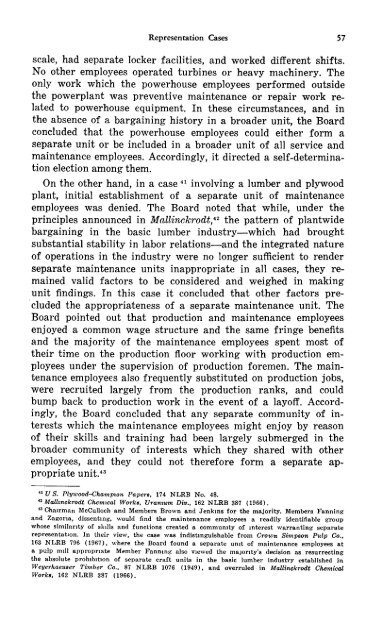1 - National Labor Relations Board
1 - National Labor Relations Board
1 - National Labor Relations Board
Create successful ePaper yourself
Turn your PDF publications into a flip-book with our unique Google optimized e-Paper software.
Representation Cases 57<br />
scale, had separate locker facilities, and worked different shifts.<br />
No other employees operated turbines or heavy machinery. The<br />
only work which the powerhouse employees performed outside<br />
the powerplant was preventive maintenance or repair work related<br />
to powerhouse equipment. In these circumstances, and in<br />
the absence of a bargaining history in a broader unit, the <strong>Board</strong><br />
concluded that the powerhouse employees could either form a<br />
separate unit or be included in a broader unit of all service and<br />
maintenance employees. Accordingly, it directed a self-determination<br />
election among them.<br />
On the other hand, in a case 41 involving a lumber and plywood<br />
plant, initial establishment of a separate unit of maintenance<br />
employees was denied. The <strong>Board</strong> noted that while, under the<br />
principles announced in Mallinckrodt, 42 the pattern of plantwide<br />
bargaining in the basic lumber industry—which had brought<br />
substantial stability in labor relations—and the integrated nature<br />
of operations in the industry were no longer sufficient to render<br />
separate maintenance units inappropriate in all cases, they remained<br />
valid factors to be considered and weighed in making<br />
unit findings. In this case it concluded that other factors precluded<br />
the appropriateness of a separate maintenance unit. The<br />
<strong>Board</strong> pointed out that production and maintenance employees<br />
enjoyed a common wage structure and the same fringe benefits<br />
and the majority of the maintenance employees spent most of<br />
their time on the production floor working with production employees<br />
under the supervision of production foremen. The maintenance<br />
employees also frequently substituted on production jobs,<br />
were recruited largely from the production ranks, and could<br />
bump back to production work in the event of a layoff. Accordingly,<br />
the <strong>Board</strong> concluded that any separate community of interests<br />
which the maintenance employees might enjoy by reason<br />
of their skills and training had been largely submerged in the<br />
broader community of interests which they shared with other<br />
employees, and they could not therefore form a separate appropriate<br />
unit.43<br />
41u S. Plywood—Champton Papere, 174 NLRB No. 48.<br />
4' Mallinckrodt Chemical Works, Uranium Div., 162 NLRB 387 (1966).<br />
" Chairman McCulloch and Members Brown and Jenkins for the majority. Members Fanning<br />
and Zagoria, dissenting, would find the maintenance employees a readily identifiable group<br />
whose similarity of skills and functions created a community of interest warranting separate<br />
representation. In their view, the case was indistinguishable from Crown Simpson Pulp Co.,<br />
163 NLRB 796 (1967), where the <strong>Board</strong> found a separate unit of maintenance employees at<br />
a pulp mill appropriate Member Fanning also viewed the majority's decision as resurrecting<br />
the absolute prohibition of separate craft units in the basic lumber industry established in<br />
Weyerhaeuser Timber Co., 87 NLRB 1076 (1949), and overruled in Mallinckrodt Chemical<br />
Works, 162 NLRB 387 (1966).

















